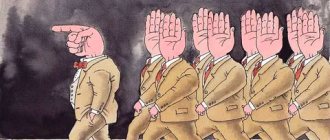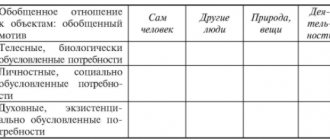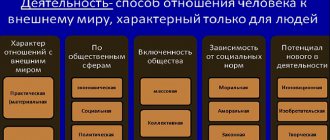In philosophy, there are two such fundamental terms - sensory knowledge and rational knowledge. The first concept is cognition through the prism of the instinctive sensations known to us: hearing, sight, smell, taste and touch.
The second form of accepting the surrounding reality is carried out through thinking. We will look at both examples of the sense of touch in this world in more detail in this article.
What is sensory knowledge?
Sensory cognition is a set of methods for understanding the world around us. Traditionally it is contrasted with thinking, which is secondary. The type of mastering reality with the help of feelings does not rely on a mental analysis of the properties of any objects. The anatomical and physiological system allows us to form specific images and obtain primary knowledge about the external side of objects. The five main senses are responsible for this:
- vision;
- hearing;
- taste;
- sense of smell;
- touch.
Sensory cognition
The essence
A person has several sense organs: eyes, nose, tongue, skin and ears. These sense organs are responsible for comprehending the world and allow us to interact with it in the following ways:
Vision, or visual perception, allows a person to see the surrounding reality. Vision is the basis for images of an existing object, which then emerge in the human mind.
Hearing is the perception of sound. Sound vibrations through the ears enter the brain, which determines what we hear: the sound of the surf, or the singing of birds, or maybe the words spoken by another person?
Touch - or tactile perception. We can feel surrounding objects by touching them. For example, you can pet a cat and realize that it is soft and fluffy.
The sense of smell is smells. Smells also form images. For example, you go home after school, hungry, and when you go up the stairs, you smell the delicious smell of chicken and potatoes. And in your mind the image of a large dish with roasted chicken and potatoes immediately appears, next to it there is cold kvass and chopped onions... Mmm! But this is just an image created by your sense of smell and the power of your mind.
Taste. Language allows us to taste things. This is why small children put everything in their mouth - they want to perceive the object with all their senses - this is instinct.
Psychology of sensory cognition
From a psychological point of view, cognition is a process that occurs in several stages. At the first stage, the external world and all objects in it are literally “imprinted” into the human psyche. The second stage is comprehension, that is, the formation of concepts and judgments. The final stage is “exit” from the psyche, when an idea comes, knowledge is formed that allows you to interpret the original feelings.
Sensory knowledge is inherent only to man. In animals it is observed to a lesser extent; with its help they gain the necessary experience. The thinking and sensory cognition of people differ from animals in that they are biosocial. We can say that cognitive abilities have evolved and become humanized. Without rationality it is impossible to penetrate into the essence of things and understand the cause of phenomena. These are parties to a single process.
Rational knowledge and its forms
Now let’s briefly look at the features of rational cognition. This form of research into this world differs from instinctive perception in that it is based on logical thinking and accumulation of knowledge.
An abstract train of thought helps us go beyond sensory knowledge and make important decisions.
Rational cognition includes three methods of touch:
- Concept
characterized by the ability to create a collective concept about a particular subject. For example, the concept of “notebook” will have a general concept and a set of specific characteristics for a person that do not depend on time or location.
- Judgment
is a special form of cognition that is capable of summing up the number of available concepts and forming one’s own judgment about the environment. This also includes the relationship between life events and circumstances on the basis of which a person draws certain conclusions. For example, to conclude what psychology is, it will not be enough for us to read one rule in a textbook. To do this, you need to learn a lot of concepts from psychology and study the topic in depth in order to finally form your own subjective opinion.
- Inference
, in turn, is based on a set of judgments and helps us find the truth. To form a final opinion, it is not enough to collect a certain number of concepts. To do this, by collecting judgments, you need to make a single conclusion that will be true for a person.
In a word, rational knowledge is a reasonable approach to a particular issue. To successfully use this type of touch, you need to be good at logic and abstract thinking. To do this, it is necessary to increase your level of operating judgments, concepts and conclusions.
Sensory knowledge in philosophy
The special science of epistemology (from the Greek gnosis - knowledge, logos - teaching), which considers cognition as a phenomenon, belongs to the section of philosophy. There is a separate movement in it: sensationalism (from the Latin sensus - perception), one of the postulates of which is: in the mind there cannot but be something that would not have previously arisen in the feelings. The most important question that worries thinkers is: do people adequately assess reality? The famous German philosopher Immanuel Kant said that the comprehension of everything begins with experience - the “work” of the senses - and he identified several stages in it:
- emotions;
- reason;
- mind.
Even the ancient Greek philosophers believed that the most basic and reliable form of mastering reality is sensations and feelings. Domestic philosophical literature, based on the works of V.I. Lenin, distinguished them as an independent level, lower in relation to abstract thinking. Modern science refutes old theories because thinking in emotional and non-sensual forms is different, but each has its own advantages and cannot be inferior to the other. The ability for sensory cognition is inherent in everyone.
Subject and object of knowledge. Cognition and Practice
Cognition is a special type of human activity aimed at understanding the world around us and ourselves in this world. An important feature of cognitive activity is its awareness. Cognition is a form of a person’s active relationship to reality. The subject and object of cognition are aspects of cognitive activity. To determine the essence of cognitive activity, it is necessary to turn to the content of the concepts “subject” and “object” of cognition.
The modern interpretation of the concept of “subject” was first presented by Descartes and is associated with the opposition of subject and object. In this case, the subject of cognition is considered as an active principle in the cognitive process. The object of cognition is what the subject’s cognitive activity is directed towards (in Kant’s terminology, the “thing in itself”). The subject of cognition can be an individual person, a group of researchers; in a sense, society acts as a subject of cognition in relation to nature. The object of knowledge is a very general concept that includes natural phenomena, other people with their consciousness, one’s own human body, and the products of one’s mental activity.
It is necessary to distinguish between the object and the subject of knowledge. Man as an object of study is common to a significant part of the natural and all social sciences. But the objects of knowledge in biology and medicine are the physical structure of a person, the physiological processes occurring in his body, and, to some extent, mental processes, as they relate to human health as a whole. In the social sciences, man as a social being is the subject of knowledge, and each of these sciences studies man, and therefore man, from a certain point of view.
The formation of a subject of cognition presupposes the formulation of the task of cognition, the choice of means and methods of cognition.
The development of the doctrine of the subject of knowledge brought with it the need to consider knowledge in close connection with practice. In the history of philosophy, the category of practice was developed for a long time outside the doctrine of knowledge. The connection between cognition and praxis received the most detailed development in Marxism. Marx characterized praxis as a specifically human, conscious, purposeful, material (sensual, subjective) activity of people to change the world.
Thus, although praxis is a material activity, it is an objective one in which the material and spiritual aspects form a unity. The spiritual moment of activity provides material activity, but it is not the leading side of practice. Practice is material due to its prerequisites, means and final results.
There are many types of practice, they include material production, social practice, which has a large number of its varieties. Social practice is the activity of establishing, reproducing and transforming social relations: economic, political, legal, moral, national, interstate, everyday, marriage and family, etc. A special type of practice is technical activity, which includes design as its elements and project activities (design) of people. Engineering activities are aimed at transforming various devices created by people, with the help of which the environment is changed. Currently, the relationship between various types of practice is changing significantly, and a more important place is occupied by its special type - scientific practice (scientific experiment).
Considering cognition in unity with practice helps explain why cognition is not an absolutely independent activity, but is a process determined by the needs of practice. It is the requirements of practice that stimulate cognitive activity. Cognition develops under the influence of the practical needs of social life and improves as social practice develops.
This position is illustrated by the fact that cognition is formed on the basis of all social activities of people.
It provides the cognitive process with the necessary factual material, which is systematized, generalized and processed, as well as with instruments and technical means.
Sensory cognition - pros and cons
If you compare rationalism and sensationalism, you can find their pros and cons. Emotions and sensations play a primary role in getting to know the outside world; moreover, a person acquires this type of knowledge himself and quickly. But the sensory way of knowing the world is limited and has its drawbacks:
- there are limits to this process;
- there are errors;
- it is subjective;
- reflects only the characteristics of various objects;
- people's consciousness is much more complex and broader than a set of impressions;
- the content of the intellect cannot be reduced to images and sensations.
Types of sensory cognition
Sensory knowledge of the world is carried out using the sensory system. Each analyzer is influenced by the entire system. Several types of perception are formed:
- using hearing;
- vision;
- tactile contact;
- sense of smell;
- taste buds;
- vestibular apparatus.
Some argue that intuition is sensory knowledge. However, it stands apart from rationalism and sensationalism and is the ability to comprehend the truth as a result of “insight.” Intuition does not rely on sensations and logical evidence. We can call it a peculiar form of two things - both rational and irrational judgment.
Differences between sensory and rational cognition
What is the difference between sensory and rational thinking? The following table will help you figure this out:
Rational and instinctive sense of touch differ significantly in the characteristics and mechanism of involvement of the nervous system. But they are a single whole, since without one form of knowledge the other cannot exist.
Separately, philosophers identify this method of cognition as intuition. This concept can be called mystical, since knowledge suddenly comes to a person’s mind with the help of intuition without substantiated evidence.
The role of sensory cognition
Without sensory organs, a person is not capable of comprehending reality. Only thanks to his analyzers does he keep in touch with the outside world. The processes of sensory cognition are involved when there is a need to obtain information about a phenomenon, although it will be superficial and incomplete. If an individual has lost part of the means for contemplation (blind, deaf, etc.), compensation will occur, that is, other organs will begin to work at an increased pace and mode. The imperfection of the human body and the importance of biological sensors are especially noticeable when the deficiencies are congenital.
Types of knowledge (scientific, creativity, self-knowledge)
It is customary to distinguish 7 types of knowledge:
- Ordinary involves the daily acquisition of basic information about the structure of the world. You can call it receiving life experience: living and understanding.
As a result, the individual understands what to do and what not to do, what is good and what is bad for him, masters ideas and builds cause-and-effect relationships that in the long term make his life better.This type of cognition is available to both adults and children. A child, playing in the sandbox, learns that if you pour sand on someone’s head, he will not be praised for it - he will also be punished. A housewife who accidentally adds an extra pinch of salt to a dish comes to the unexpected conclusion that it makes the food much tastier.
- Scientific knowledge is based on logic, studying cause-and-effect relationships.
Scientists put forward hypotheses (what is it?), which are confirmed or refuted during the research process. This type is also called rational, that is, based on common sense and objectivity. - Mythological - it was once an integral part of primitive society.
Ancient people did not bear any responsibility for anything, throwing it off to the forces of nature. For example, if a person fell from a cliff and died, it was not because the latter was careless and did not calculate his physical strength, but because he was taken by one of the divine beings, of which there were many invented at that time. It should be noted that in the modern world mythological knowledge also exists. It is adhered to mainly by those who are far from science or those who, due to their psychological characteristics, do not want to be responsible for their actions and mystify life events (especially negative ones). - Religious - aimed at studying relationships with God. It is interesting that the latter here plays the role of both subject and object. Religious consciousness perceives reality as God's providence, aimed at good thoughts and actions, and is in anticipation of feedback from above.
- Artistic knowledge and creativity is a way of reflecting reality through symbols and images.
It is limitless and cannot be analyzed or proven. It is a product of mental activity based on the ideas of the creator. For example, futuristic paintings, as a reflection of the artist’s inner world, contain illogical, inexplicable images that cannot be subjected to scientific research, however, they have every right to exist. - Philosophical knowledge is concerned with defining the role of man, searching for the meaning of life through the prism of the categories of good and evil. Philosophy tries to study the essence of human existence and answer “eternal” questions regarding existence. Who are we, why do we live, why was the world created, what is truth, etc.
- Self-knowledge is the study of one’s own states: moods, thoughts, thoughts and actions. This is an analysis of one’s personality, leading to an awareness of one’s needs, goals and motives, which helps a person to be confident in himself and his abilities, not to depend on the crowd and its stereotypes.
Signs of sensory cognition
Both people and animals know how to use sensory knowledge. But there is an important element inherent only to intelligent beings: the ability to imagine something that one has not seen with one’s own eyes. The specificity of people's sensory cognition is that they form images based on the stories of others. Therefore, we can talk about the enormous role of language in the implementation of the cognitive process with the help of sensory organs. The main feature of sensationalistic perception is a direct reflection of the surrounding reality.
Concept and characteristics
Sensory cognition is the formation in a person of ideas about the reality around him at the instinctive level.
Such cognition is made possible through vision, smell, touch, hearing and taste.
This form of perception of reality is inherent not only to people , but also to animals. By receiving certain impressions and sensations from the surrounding nature, animals accumulate experience and knowledge, which they later use for the purpose of survival.
The same principle applies to people. Based on his visual, auditory, taste or other ideas, a person learns about the world around him and draws his own conclusions .
The systematic receipt of information allows you to accumulate individual knowledge and form your own opinion about certain phenomena and processes.
Since people are social creatures , sensory knowledge alone is not enough for full functioning in society. Relying only on their emotions, individuals can commit irrational, thoughtless actions.
For this reason, the sensory sphere is always under the control of the mind , which has a restraining and regulatory effect.
Weighted, deliberate decision-making is usually more effective than emotional impulse based on feelings.
Methods of sensory cognition
There are many sets of operations and techniques through which cognition is carried out. All methods are divided into two types: empirical and theoretical. Due to the peculiarity of sensory cognition, most theoretical (or scientific) techniques, such as analysis, deduction, analogy, etc., are not applicable to it. Creating an impression of objects is possible only through the following actions:
- Observation is the perception of phenomena without interfering with them.
- Measurement is the determination of the relationship of the measured object to the reference one.
- Comparison – identifying similarities and differences.
- Experiment - placing objects and phenomena in controlled conditions and studying them.
Essay on the topic “Specificity and forms of sensory knowledge”
Essay on the topic: “Specificity and forms of sensory knowledge”
This topic is relevant, in my opinion, since cognition is a system of methods for achieving knowledge about the objective world. Knowledge is the unity of sensory and rational knowledge, therefore they are closely interconnected.
Cognition of the objective world through sensory cognition (or it is also called sensitive cognition) occurs with the help of the senses and gives specific knowledge about an object and its properties. Sensory cognition consists of the following forms: sensation, perception and representation.
Currently, the study of sensory cognition by specialists is an important problem, since sensory cognition represents knowledge about specific properties and objects of reality. And scientists consider this phenomenon from the point of view of the reliability of information, the deceptiveness of feelings and the application of such knowledge in practice.
In order to understand all the nuances of sensory cognition, it is necessary to consider this concept in detail, identify the specifics and consider the forms of sensory cognition.
Sensory cognition is one of the most fundamental and simple forms of cognition. It begins with sensations that arise through certain influences of the objective world on the human senses. There are five main types of sensations affecting the senses: hearing, vision, taste, smell and touch. The main one among these types is vision, since it represents the largest part of sensory information. A person may not be aware of specific sensations because they are an example of the smallest atoms of a person's sensory experience. A synthesis of sensations in perception manifests itself in people's minds.
Perception is characterized not by individual sensations, but by stable properties that preserve objects. The main property of perception is its objective nature, which shows that a person perceives not a specific sensation, but an object as a whole. Thus, one can see the work of consciousness at the level of perception not only by the senses, but also by the mind.
In philosophy, there are two types of knowledge – sensory and rational. Sensory cognition, as mentioned above, is associated with the performance of human senses. and rational knowledge is the activity of the human mind, i.e. his abstract and conceptual thinking.
Let's consider the forms of sensory knowledge:
1. Sensation is a process in the psyche, which consists of remembering any properties of an object or phenomenon of the objective world during its direct impact on the human senses.
Sensation is considered as the initial element of sensory knowledge. From the position of information ability, vision and touch come first, followed by hearing, smell and taste. Sensation is a subjective reflection of an object, since it refracts the action of an object with the help of human consciousness. For example, pain from a burn (fire has no pain).
Sensation reflects the connection of the subject with the objective world, and it depends on the human body and its senses. However, despite the duality of dependence on the object and the subject, in practice, a person has developed the action of evaluating and daily using objective information about an object that comes from sensations.
Although a person, with the help of his sense organs, senses spatial color, smell, shape, taste, and at the same time, the sense organs are capable of synthesizing sensations, turning them into perception, which has a certain property: through perception, an object in a person’s mind appears in a holistic form, that is in the form of an integrity independent of consciousness. It is perception in sensation that acquires the quality of a subjective image of the objective world.
2. Perception is a general reflection of objects and phenomena with direct influence on human senses through consciousness. The most important factors of perception: objectivity, integrity and structure.
Perception exists as a type of synthesis of the diversity of manifestations of an object, inextricably linked with other factors of practical and cognitive activity. For example, a person cannot directly feel a certain part of a house, but his perception synthesizes the image of the house as a whole and those parts that he does not feel. Thanks to the enormous work of perception mechanisms, a whole image of an object is retained in a person’s consciousness (in his memory), even when the object is not near the person. In this case, a complex form of sensory cognition—representation—begins to function.
3. Representation - images of objects affecting a person’s senses and preserved in his memory. A distinctive feature of representation from sensation and perception is that the human senses may not be directly involved with the object.
There are representations of imagination and memory, visual and tactile (an important role in blind people) representations, olfactory, auditory and other types of representations are also known. The idea relates to a specific subject, but can also represent a general picture, while their commonality is far from being the same, but rather different.
In philosophy, representation is characterized by two relations. The first is a clear characteristic of a person’s specific consciousness, since it was believed that representation, in contrast to sensation and perception, which relates the subject to the external world, representation is a special formation that has its own content, where the object corresponds or does not correspond to reality. In this understanding, a representation is a kind of picture that is located in the human mind. A person has direct access to these pictures and can look at them through the “inner eye” - this is introspection.
Second, representation in philosophy was considered as obtaining knowledge about the subjective world. D. Berkeley, D. Locke, E. Mach, D. Hume and other philosophers believed that thanks to representation the possibility of thinking is ensured. In their opinion, all knowledge and its content is represented in sensation and perception.
What is the structure of sensory cognition? All sensory knowledge is immediate. Sensory images arise due to the fact that an object and its properties directly affect the nervous system and sensory organs of a person. Sensory cognition is the passage through which man comes into contact with the objective world. From the point of view of dialectical materialism, the forms of sensory knowledge are subjective images of the objective world, that is, their meaning is objective, since it is established by external influence, and not by the consciousness of the subject.
Let us expand on the concept of “subjective image,” which means that the ways of perceiving sensations depend on how the human nervous system is structured. For example, humans cannot perceive magnetic waves and radio, unlike animals. The eagle is more perspicacious than man, far-sighted, but man notices objects and sees more than the eagle. A dog has a subtle sense of smell, but it cannot distinguish between one smell and thousands of those smells that are different to humans. The subjectivity of the image is based on the interaction of two forms of matter, sensation, which are reflected in the human nervous system. For example, the taste of sweet or salty in relation to the tongue, and not to water, the smell of flowers in relation to the sense of smell.
But, there is a theory in the history of philosophy, according to which human perceptions and sensations are not images, not copies, but just conventional symbols, signs, hieroglyphs that do not have a common factor with objects and their properties. This concept was formed by the German physiologist G. Helmholtz, based on the concept of the German naturalist (physiologist) J. Muller. Based on Müller’s theory, the peculiarity of sensations is formed not by the nature of things and objects, but by the peculiar structure of the human sense organs, which represents a closed system for each individual (the law on the specific energy of the sense organs). For example, the sensation of a bright flash arises both from exposure to bright light and from a strong blow to the eye, that is, human senses, according to Muller’s theory, do not give any absolute idea of the quality of a phenomenon or object.
From the point of view of dialectical materialism, this theory is a semblance of agnosticism, since signs and symbols are permissible (possible) in relation to non-existent things, that is, to brownies, goblins, etc.
But, still, do a person’s senses present an adequate picture of reality? Even L. Feuerbach noted that a person is given as many sense organs as necessary for correct knowledge of the objective world. If a person’s feelings did not reflect the objective world as it appears to them, then a person, like any animal, would not be able to adapt to the world around them, that is, to survive. In addition, this occurrence from the point of view of doubt represents the correctness of the reflection of reality, otherwise humanity would not doubt this factor.
Let us consider what sensory cognition gives a person: knowledge of specific properties, attributes of objects, external connections between a person and an object, that is, sensory cognition gives a person knowledge of the concrete, individual and visible. Knowledge of the essential, general, abstract and natural is transmitted through rational knowledge (mind). Naturally, when studying a specific subject, a person also gets an idea of the totality of individual objects. Consequently, the fact of common connections and the common appears to be sensory knowledge. But, only reason can highlight this general and separate it from the specific, particular and individual.
The meaning and role of sensory cognition was determined by schools such as the rationalist school (Kant, Descartes, Hegel, Leibniz and Spinoza) - they were based on rational cognition, without denying the importance of sensory cognition as a connecting factor of the mind with the objective world. Another school - empirical (Locke, Hobbes) believed that sensory knowledge is the main and perhaps the only source of knowledge.
Thus, we can summarize that sensory cognition is a specifically human character, that is, historically social. Of course, in sensory cognition a person occupies an important place in interaction with the object and sense organs. But, a person cannot discover in real cognitive activity the feeling of knowledge in a separate (pure) form - outside the world around him, outside of communication with the people with whom he is connected.
The functioning of the senses is a necessary element of cognition, without which any perception is difficult. As long as all human sense organs function in a normal rhythm, a person can notice their role, but this role is noticeable only when damaged. For example, deaf and mute people can be full-fledged people, having developed the abilities of cognition and rational thinking within their body, mind. And Mowgli children, on the contrary, lose their ability to learn. This means that a person and his sensory-practical activity is connected with sensory knowledge, which is a historical and social phenomenon.
There is another important element in human perception that is unique to it. A person is able to visualize not only what he sees with his eyes, but most of it includes pictures from descriptions of his life. That is, a person’s individual experience can be replaced to a certain extent by the results of the experiences of his predecessors. Today, with the development of technology, this ability has become unlimited.
BIBLIOGRAPHY
- Alekseev P.V. Social philosophy: Textbook. – M.: TK Velby LLC, 2003. – 289 p.
- Alekseev P.V. Panin A.V. Theory of knowledge and dialectics. – M., 1991. – 370 p.
- Ilyin V.V. Theory of knowledge. Introduction. Common problems. – M., 1994. – 385 p.
- Lektorsky V.A. Theory of knowledge (epistemology, epistemology) // Questions of Philosophy, 2008. No. 8. – P. 72 – 80.
- Russell B. History of Western Philosophy. – M., 1959. – 234 p.
- Rushkvich M.I., Loifman I.Ya. Dialectics and theory of knowledge. – M., 1994. – 428 p.
- Philosophy: Textbook / Ed. prof. V.N. Lavrinenko. – 2nd ed., rev. and additional – M.: Lawyer. 2004. – 421 p.
- Philosophical Dictionary / Ed. I. T. Frolova. – 5th ed. – M.: Politizdat, 1987. – P. 291.
- Philosophy: lecture notes: textbook. allowance / V.O. Bernatsky; under general ed. N.P. Flywheel. – Omsk: Omsk State Technical University Publishing House, 2008. – 294 p.
6








